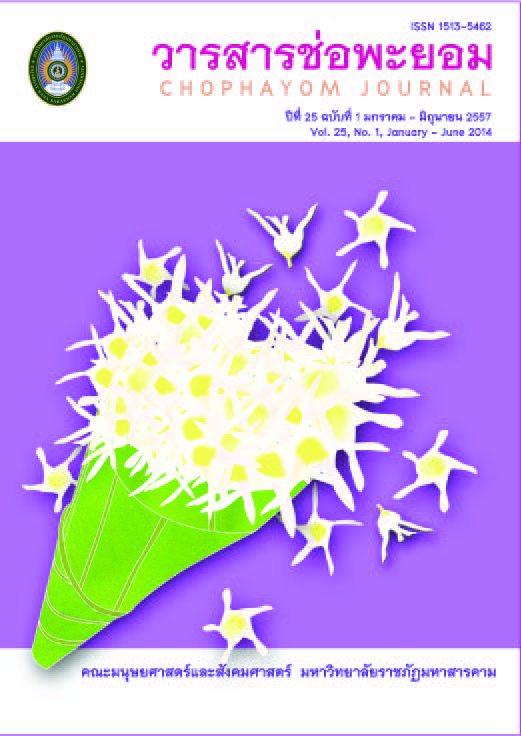รูปแบบการบริหารจัดการห้องสมุดมหาวิทยาลัยราชภัฏให้เป็นองค์การแห่งการเรียนรู้ (A Management Model for Rajabhat Universities’ Libraries as Learning Organizations)
Abstract
บทคัดย่อ
การวิจัยนี้มีวัตถุประสงค์เพื่อ 1) ศึกษาสภาพการเป็นองค์การแห่งการเรียนรู้ของห้องสมุดมหาวิทยาลัยราชภัฏในปัจจุบัน 2) ศึกษาปัญหา อุปสรรค และปัจจัยสนับสนุนในการเป็นองค์การแห่งการเรียนรู้ของห้องสมุดมหาวิทยาลัยราชภัฏ 3) สร้างรูปแบบการบริหารจัดการห้องสมุดมหาวิทยาลัยราชภัฏให้เป็นองค์การแห่งการเรียนรู้ โดยใช้วิธีการวิจัยแบบผสานวิธี (Mixed Method Research) โดยดำเนินการ 2 กิจกรรม คือ
กิจกรรมที่ 1 การศึกษาสภาพ ปัญหาอุปสรรค และปัจจัยสนับสนุนในการเป็นองค์การแห่งการเรียนรู้ของห้องสมุดมหาวิทยาลัยราชภัฏในปัจจุบัน โดยการสัมภาษณ์แบบเจาะลึก (In-dept Interview) ผู้บริหารห้องสมุดมหาวิทยาลัยราชภัฏ จำนวน 10 คน
กิจกรรมที่ 2 การสร้างรูปแบบการบริหารจัดการห้องสมุดมหาวิทยาลัยราชภัฏให้เป็นองค์การแห่งการเรียนรู้ประกอบด้วย 2 ขั้นตอน คือ 1) การสร้างรูปแบบการบริหารจัดการห้องสมุดมหาวิทยาลัยราชภัฏให้เป็นองค์การแห่งการเรียนรู้ โดยการสัมภาษณ์แบบเจาะลึก (In-dept Interview) ผู้ทรงคุณวุฒิด้านห้องสมุดสถาบันอุดมศึกษา จำนวน 8 คน แล้วนำข้อมูลมาวิเคราะห์และสังเคราะห์ นำเสนอเป็นรูปแบบการบริหารจัดการ 2) การศึกษาความสำคัญของรูปแบบการบริหารจัดการห้องสมุดมหาวิทยาลัยราชภัฏให้เป็นองค์การแห่งการเรียนรู้ โดยสอบถามระดับความคิดเห็นจากผู้บริหารห้องสมุดมหาวิทยาลัยราชภัฏทั่วประเทศ จำนวน 200 คน แล้วนำข้อมูลมาวิเคราะห์เพื่อหาค่าเฉลี่ย และส่วนเบี่ยงเบนมาตรฐาน
ผลการวิจัยพบว่า
1. สภาพการเป็นองค์การแห่งการเรียนรู้ของห้องสมุดมหาวิทยาลัยราชภัฏในปัจจุบัน ประกอบด้วย 1.1) ด้านความรอบรู้และเชี่ยวชาญของบุคคล (personal mastery) พบว่า บุคลากรมีความกระตือรือร้นที่จะศึกษาหาความรู้อยู่เสมอ ทำให้มีความรู้ความสามารถด้านทักษะวิชาชีพในระดับหนึ่ง ผู้บริหารมีนโยบายให้บุคลากรพัฒนาตนเองอย่างต่อเนื่องเพื่อพัฒนาความสามารถตามสมรรถนะของตำแหน่ง 1.2) ด้านรูปแบบความคิด (mental models) พบว่า บุคลากรมีรูปแบบการคิดตามกรอบวิชาชีพของตนเอง มีความพร้อมที่จะแลกเปลี่ยนเรียนรู้กับหน่วยงานอื่น ๆ และจะปรับเปลี่ยนความคิด ทัศนคติ และความเชื่อด้วยข้อมูลใหม่ ๆ 1.3)ด้านวิสัยทัศน์ร่วม (shared vision) พบว่า บุคลากรทุกฝ่ายกำหนดวิสัยทัศน์ร่วมกัน และผู้บริหารห้องสมุดถ่ายทอดวิสัยทัศน์สู่ผู้ปฏิบัติงาน เพื่อนำไปเป็นแนวทางในการจัดทำแผนกลยุทธ์ และแผนปฏิบัติการของห้องสมุด 1.4) ด้านการเรียนรู้เป็นทีม (team learning)พบว่า ห้องสมุดให้ความสำคัญกับการเรียนรู้เป็นทีม โดยมีลักษณะการเรียนรู้งานแบบข้ามสายงาน และเรียนรู้การทำงานแบบโครงการ 1.5) ด้านการคิดอย่างเป็นระบบ (systems thinking) พบว่า บุคลากรสามารถมองภาพรวมของการทำงานทั้งหมดได้อย่างเป็นระบบ และสามารถเชื่อมโยงความสัมพันธ์ในส่วนงานต่างๆ ได้มีการกำหนดขั้นตอนการดำเนินงานไว้อย่างชัดเจน โดยมุ่งเน้นกระบวนการตามวงจรคุณภาพ PDCA
2. ปัญหา อุปสรรคในการเป็นองค์การแห่งการเรียนรู้ของห้องสมุดมหาวิทยาลัยราชภัฏ พบว่าบุคลากรบางส่วนมีความรู้ความสามารถด้านวิชาชีพที่เรียนมาเพียงอย่างเดียว แต่ขาดความรู้ความสามารถอื่น ๆ ที่จำเป็นในการทำงาน มีคุณวุฒิไม่ตรงกับตำแหน่งงาน ทำให้ไม่มั่นใจในความรู้และความสามารถของตนเอง บุคลากรส่วนใหญ่เป็นศิษย์เก่า มีความคุ้นเคยกับการทำงานแบบเดิม ๆ และทำงานตามคำสั่ง บุคลากรมีภาระงานมากทำให้การจัดสรรเวลาในการแลกเปลี่ยนเรียนรู้ทำได้ไม่เต็มที่ และลักษณะการทำงานของบุคลากรเป็นแบบตั้งรับ และทำตามคำสั่งเป็นหลักจึงก่อให้เกิดการเรียนรู้และคิดสิ่งใหม่ ๆ ได้ยาก ส่วนปัจจัยสนับสนุนในการเป็นองค์การแห่งการเรียนรู้ของห้องสมุดมหาวิทยาลัยราชภัฏ ประกอบด้วย 2.1) ด้านบุคลากร พบว่า บุคลากรต้องมีความรู้ความสามารถ และเข้าใจงานโดยภาพรวมของห้องสมุด รวมทั้งบริบทวิชาชีพด้านสารสนเทศ 2.2) ด้านผู้บริหารห้องสมุด พบว่า ต้องมีเป้าหมายในการทำงานที่ชัดเจน ให้บุคลากรมีส่วนร่วมในการคิดและปรับวิสัยทัศน์ของห้องสมุด 2.3) ด้านห้องสมุด พบว่า ห้องสมุดต้องให้ความสำคัญต่อการพัฒนาบุคลากร ทั้งด้านการคิดอย่างเป็นระบบ คิดเชิงกลยุทธ์ คิดเชิงรุก และคิดนอกกรอบ ต้องมีนโยบายชัดเจนในการในการทำงานเป็นทีม และส่งเสริมการเรียนรู้ร่วมกัน เรียนรู้แบบข้ามสายงาน ข้ามหน่วยงานทั้งภายในและภายนอกมหาวิทยาลัย การถ่ายทอดแลกเปลี่ยนประสบการณ์ และความรู้ซึ่งกัน สร้างเวทีในการแสดงความสามารถอย่างสม่ำเสมอ และส่งเสริมให้ใช้กระบวนการเชิงคุณภาพ PDCA ในการทำงาน ต้องสร้างเครือข่ายการทำงานกับหน่วยงานภายในและภายนอก ต้องกำหนดให้มีการประเมินผลงานอย่างเข้มข้น เอาจริงเอาจัง
3. รูปแบบการบริหารจัดการห้องสมุดมหาวิทยาลัยราชภัฏให้เป็นองค์การแห่งการเรียนรู้ นำเสนอในรูปของ RLib LO Model ประกอบด้วยแนวทางการบริหารจัดการ 8 ด้าน ซึ่งเรียงลำดับความสำคัญในการบริหารจัดการ คือ นโยบายและแผนงาน (policies and plans) วิสัยทัศน์ร่วม (shared vision) การประเมินคุณภาพ (quality assessment) ความรอบรู้และเชี่ยวชาญของบุคคล (personal mastery) รูปแบบความคิด (mental models) การคิดอย่างเป็นระบบ (systems thinking) การเรียนรู้เป็นทีม (team learning) และการทำงานแบบเครือข่าย (networking)
คำสำคัญ : องค์การแห่งการเรียนรู้, ห้องสมุดมหาวิทยาลัย, การบริหารจัดการห้องสมุด
ABSTRACT
The purposes of this study were to investigate current characteristics of Rajabhat Universities’ libraries as learning organizations, to identify problems, barriers, and factors supporting Rajabhat Universities’ libraries as learning organizations, and to develop a management model for Rajabhat Universities’ libraries as learning organizations by using a mixed method research methodology to conduct two activities as follows:
Activity 1: In-depth interviews of ten Rajabhat Universities’ library administrators were used in identifying current problems, barriers, and factors supporting Rajabhat Universities’ libraries as learning organizations.
Activity 2: There were two steps in developing a management model for Rajabhat Universities’ libraries as learning organizations. First, in-depth interviews of eight experts on higher education institute libraries were used to develop a management model for Rajabhat Universities’ libraries as learning organizations. The data obtained were analyzed and synthesized to create the management model. Second, the significance of the management model for Rajabhat Universities’ libraries as learning organizations was explored by asking for the opinions of 200 Rajabhat Universities’ library administrators. The data were analyzed using means and standard deviations.
The results of the study showed the following:
1. It was found that the current characteristics of Rajabhat Universities’ libraries as learning organizations concerning personal mastery were that personnel were continually enthusiastic to learn and somewhat knowledgeable. The administrators had policies for the personnel to constantly improve their job competency. Regarding mental models, it was found that the personnel had mental models of their own professional frameworks, were ready for knowledge sharing with other organizations, and adapting thoughts, views, and beliefs when receiving new information. On the topic of shared vision, the results revealed that personnel from all departments jointly formed the shared vision. The library administrators transferred the vision to the personnel, so they could use it as a guide to formulate a strategic plan and a library action plan. Concerning team learning, it was found that the libraries focused on team learning as they learned a cross-functional task and project work. Relating to systems thinking, it was found that the personnel were able to systematically see an overview of all the functions and their connection. Clear operating procedures were identified using the PDCA cycle.
2. The problems found in the characteristics of Rajabhat Universities’ libraries as learning organizations were that the personnel had one vocational competency. They were not confident of their knowledge and ability. Some personnel had qualifications that did not match the job so they were concerned about being a burden to others. Most of the personnel were alumni who were used to a traditional style of working and worked by waiting for orders. The personnel had significant workloads; as a result, they could not allocate their time to completely participate in knowledge sharing. Some were not enthusiastic and did not like giving opinions. Personnel had a reactive style of working and worked by waiting for orders to follow; learning and new ways of thinking were hardly fostered.
3. Factors supporting Rajabhat Universities’ libraries as learning organizations were personnel who were knowledgeable, capable, and who understood the overall picture of a library’s functions and information professionals, library administrators who focused on personnel development by promoting such development, providing platforms for the personnel to continually and consistently display their abilities, and determinedly and intensively establishing job evaluations. The administrators, by gathering opinions from everyone involved, must encourage personnel to think and plan for work and encouraging personnel to think outside the traditional framework. The administrators had to set a clear goal, communicate the goal with all parties, and involve them in thinking about and adapting the shared vision. The administrators had to create a friendly atmosphere between administrators and staff members. Libraries should have a clear policy of learning and working as a team. Experience and knowledge exchanging should be arranged. Networking inside and outside the organization had to be created. Cross-functional task learning within and outside the universities should be supported. Libraries should provide the activities that promote systems thinking for the personnel. The PDCA cycle should be adopted and encouraged to be used in working.
4. A management model for Rajabhat Universities’ libraries as learning organizations was presented as a RLib LO Model consisting of eight management aspects – listed by the order of its priority of management: policies and plans, shared vision, quality assessment, personal mastery, mental models, systems thinking, team learning, and networking.
Keywords : Learning organization, Universities’ libraries, Management of libraries






